IFN503 Assessment 2: Analysis of TCP/IP Protocols and Security
VerifiedAdded on 2022/09/30
|11
|2560
|288
Report
AI Summary
This report provides a comprehensive overview of fundamental computer system concepts, addressing the TCP/IP protocol suite, including its characteristics, layered design, and the differences between IPv4 and IPv6. It explores the transition mechanisms between IPv6 and IPv4, and the need for dual IP stack implementation. The report then delves into the three core goals of information security: confidentiality, integrity, and availability, along with the attacks that threaten each goal. Finally, it discusses CPU management, memory management, process management, and secondary storage management, providing a holistic understanding of the essential components of computer systems.
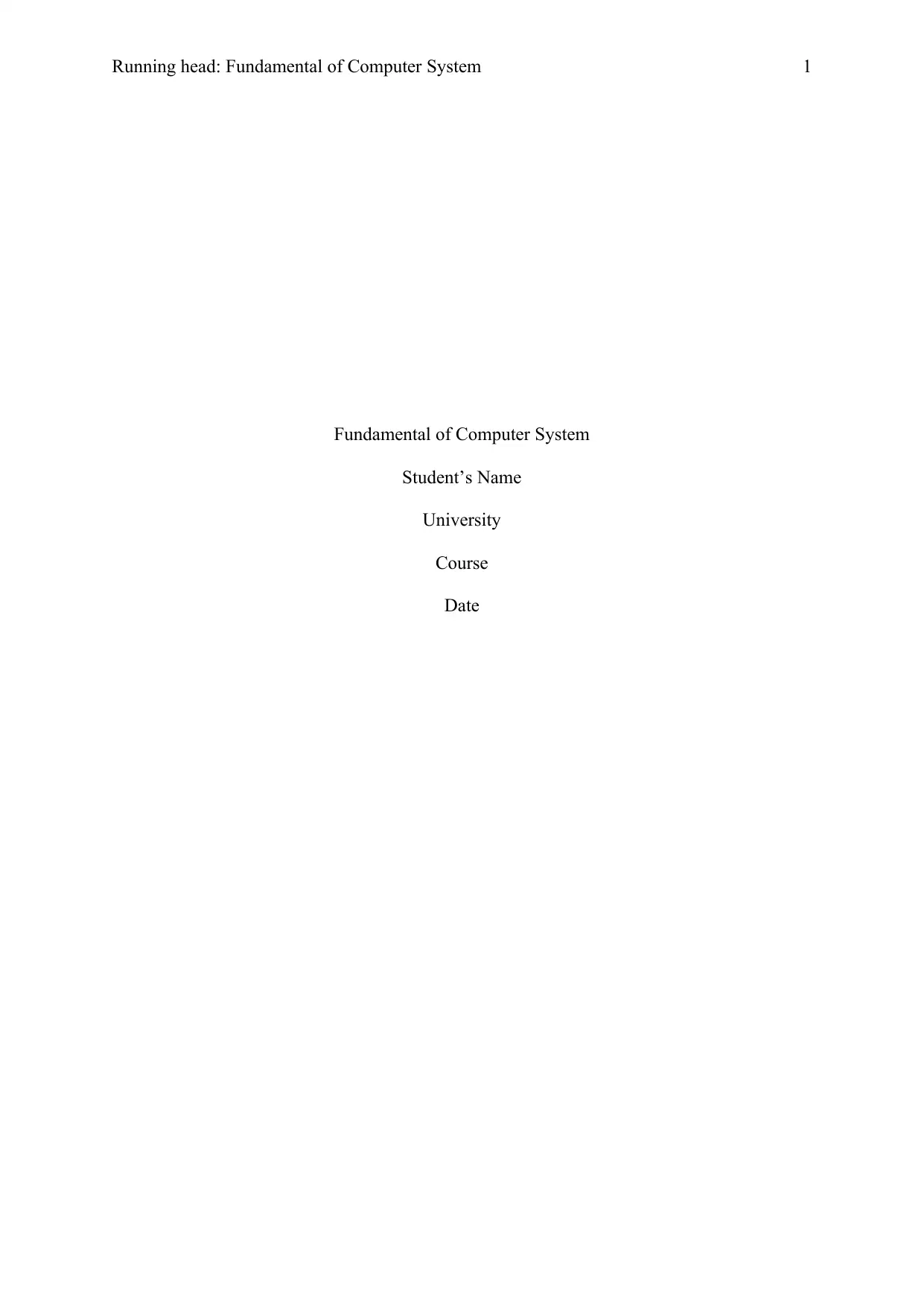
Running head: Fundamental of Computer System 1
Fundamental of Computer System
Student’s Name
University
Course
Date
Fundamental of Computer System
Student’s Name
University
Course
Date
Paraphrase This Document
Need a fresh take? Get an instant paraphrase of this document with our AI Paraphraser
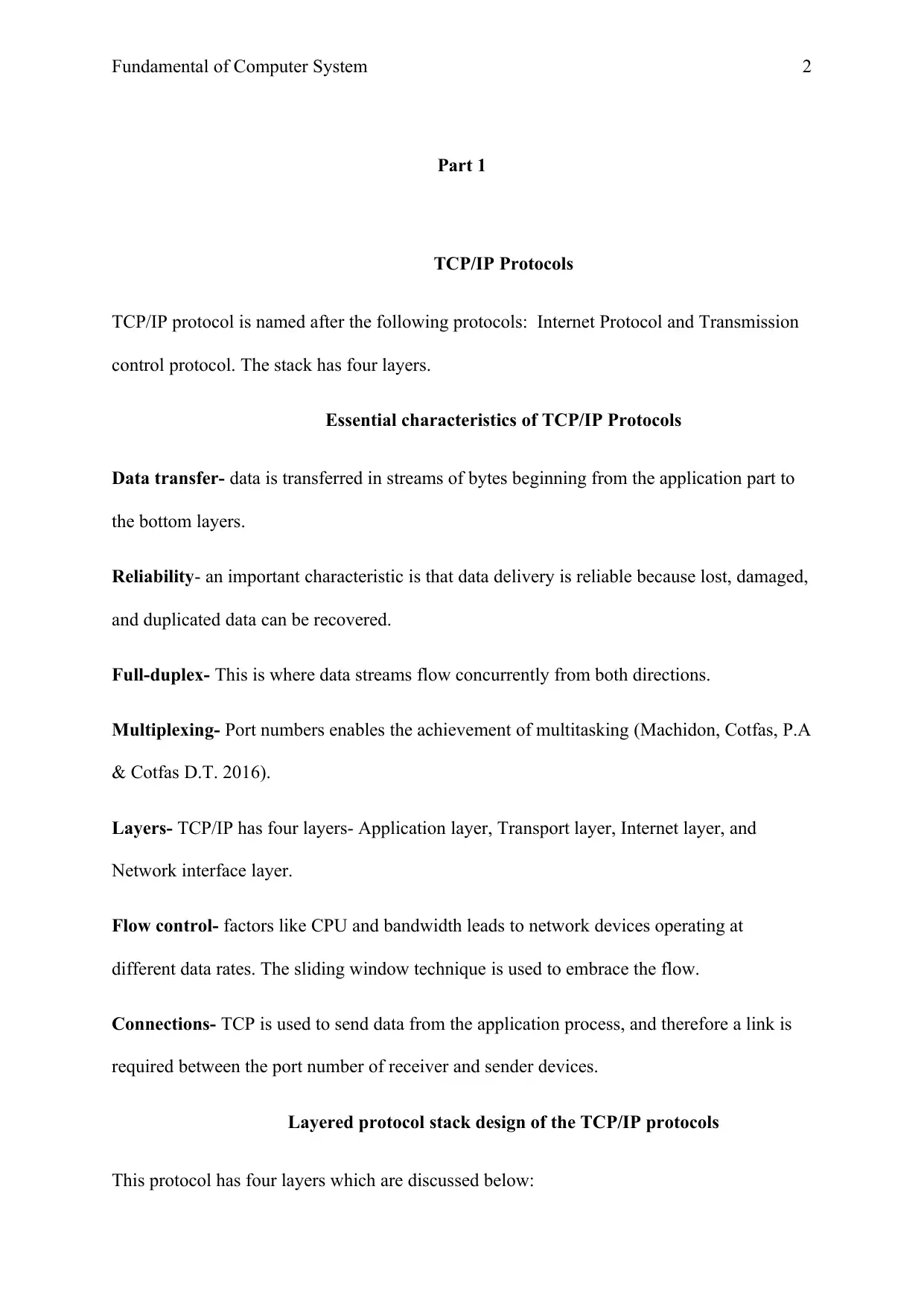
Fundamental of Computer System 2
Part 1
TCP/IP Protocols
TCP/IP protocol is named after the following protocols: Internet Protocol and Transmission
control protocol. The stack has four layers.
Essential characteristics of TCP/IP Protocols
Data transfer- data is transferred in streams of bytes beginning from the application part to
the bottom layers.
Reliability- an important characteristic is that data delivery is reliable because lost, damaged,
and duplicated data can be recovered.
Full-duplex- This is where data streams flow concurrently from both directions.
Multiplexing- Port numbers enables the achievement of multitasking (Machidon, Cotfas, P.A
& Cotfas D.T. 2016).
Layers- TCP/IP has four layers- Application layer, Transport layer, Internet layer, and
Network interface layer.
Flow control- factors like CPU and bandwidth leads to network devices operating at
different data rates. The sliding window technique is used to embrace the flow.
Connections- TCP is used to send data from the application process, and therefore a link is
required between the port number of receiver and sender devices.
Layered protocol stack design of the TCP/IP protocols
This protocol has four layers which are discussed below:
Part 1
TCP/IP Protocols
TCP/IP protocol is named after the following protocols: Internet Protocol and Transmission
control protocol. The stack has four layers.
Essential characteristics of TCP/IP Protocols
Data transfer- data is transferred in streams of bytes beginning from the application part to
the bottom layers.
Reliability- an important characteristic is that data delivery is reliable because lost, damaged,
and duplicated data can be recovered.
Full-duplex- This is where data streams flow concurrently from both directions.
Multiplexing- Port numbers enables the achievement of multitasking (Machidon, Cotfas, P.A
& Cotfas D.T. 2016).
Layers- TCP/IP has four layers- Application layer, Transport layer, Internet layer, and
Network interface layer.
Flow control- factors like CPU and bandwidth leads to network devices operating at
different data rates. The sliding window technique is used to embrace the flow.
Connections- TCP is used to send data from the application process, and therefore a link is
required between the port number of receiver and sender devices.
Layered protocol stack design of the TCP/IP protocols
This protocol has four layers which are discussed below:
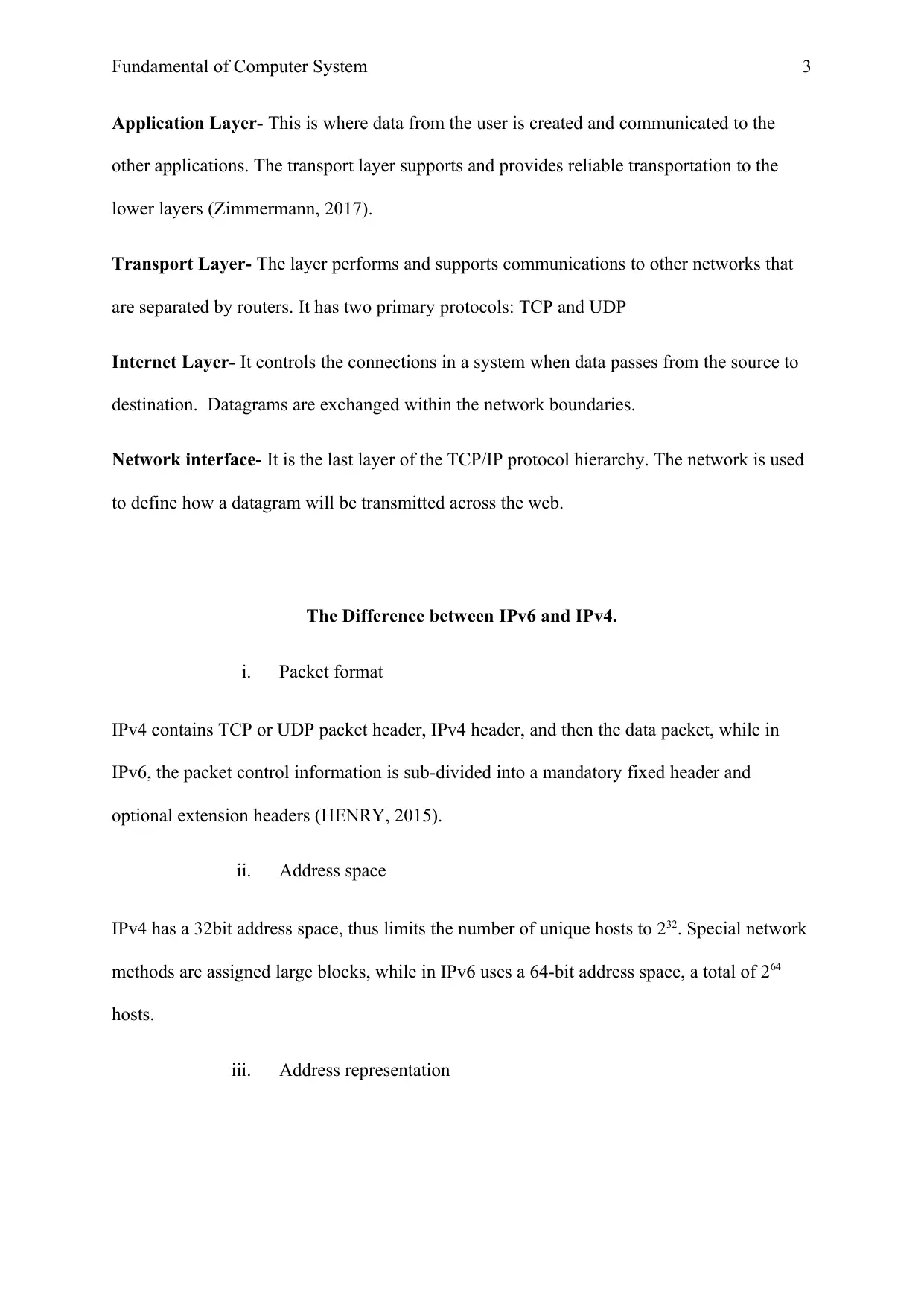
Fundamental of Computer System 3
Application Layer- This is where data from the user is created and communicated to the
other applications. The transport layer supports and provides reliable transportation to the
lower layers (Zimmermann, 2017).
Transport Layer- The layer performs and supports communications to other networks that
are separated by routers. It has two primary protocols: TCP and UDP
Internet Layer- It controls the connections in a system when data passes from the source to
destination. Datagrams are exchanged within the network boundaries.
Network interface- It is the last layer of the TCP/IP protocol hierarchy. The network is used
to define how a datagram will be transmitted across the web.
The Difference between IPv6 and IPv4.
i. Packet format
IPv4 contains TCP or UDP packet header, IPv4 header, and then the data packet, while in
IPv6, the packet control information is sub-divided into a mandatory fixed header and
optional extension headers (HENRY, 2015).
ii. Address space
IPv4 has a 32bit address space, thus limits the number of unique hosts to 232. Special network
methods are assigned large blocks, while in IPv6 uses a 64-bit address space, a total of 264
hosts.
iii. Address representation
Application Layer- This is where data from the user is created and communicated to the
other applications. The transport layer supports and provides reliable transportation to the
lower layers (Zimmermann, 2017).
Transport Layer- The layer performs and supports communications to other networks that
are separated by routers. It has two primary protocols: TCP and UDP
Internet Layer- It controls the connections in a system when data passes from the source to
destination. Datagrams are exchanged within the network boundaries.
Network interface- It is the last layer of the TCP/IP protocol hierarchy. The network is used
to define how a datagram will be transmitted across the web.
The Difference between IPv6 and IPv4.
i. Packet format
IPv4 contains TCP or UDP packet header, IPv4 header, and then the data packet, while in
IPv6, the packet control information is sub-divided into a mandatory fixed header and
optional extension headers (HENRY, 2015).
ii. Address space
IPv4 has a 32bit address space, thus limits the number of unique hosts to 232. Special network
methods are assigned large blocks, while in IPv6 uses a 64-bit address space, a total of 264
hosts.
iii. Address representation
⊘ This is a preview!⊘
Do you want full access?
Subscribe today to unlock all pages.

Trusted by 1+ million students worldwide
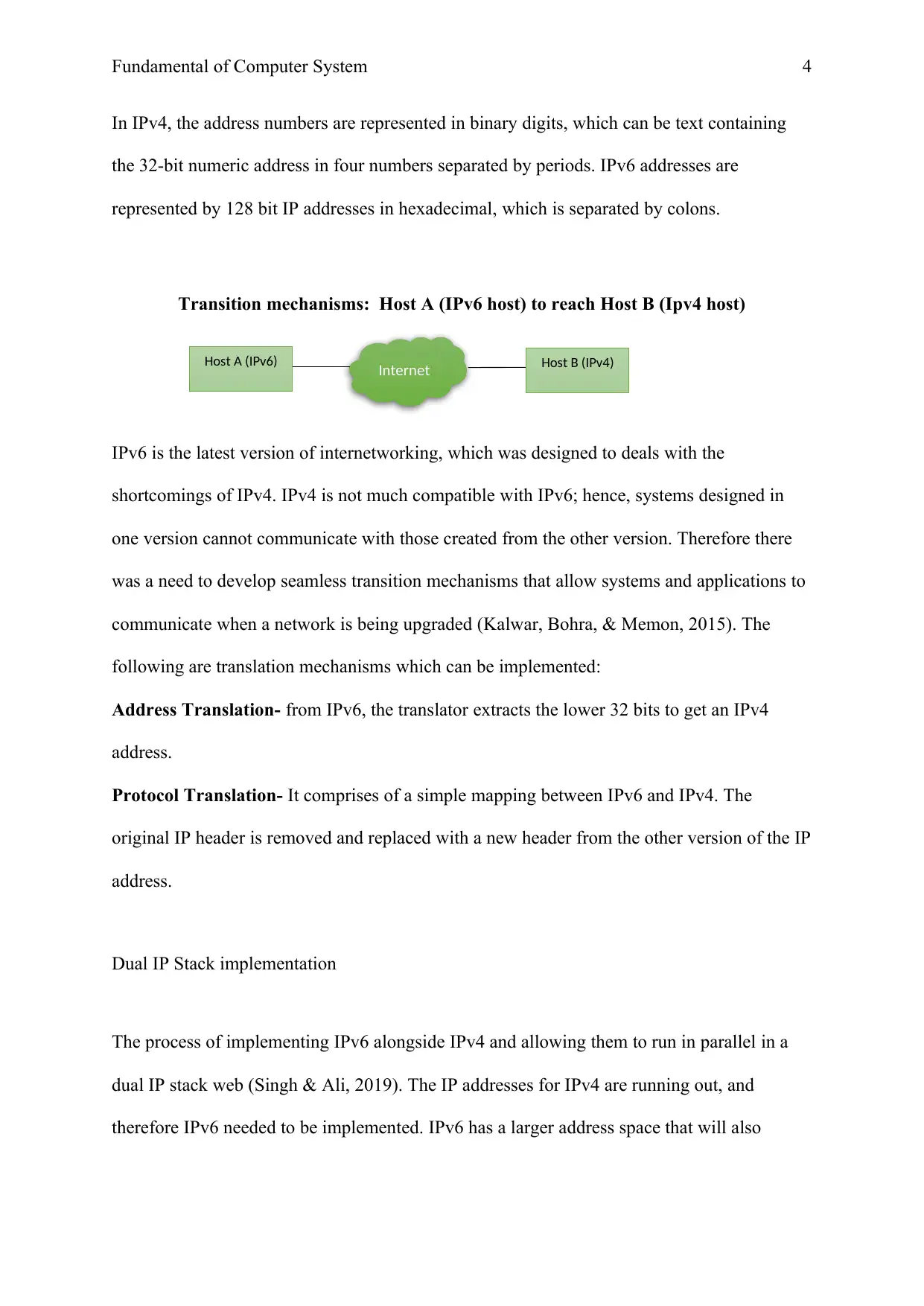
Fundamental of Computer System 4
In IPv4, the address numbers are represented in binary digits, which can be text containing
the 32-bit numeric address in four numbers separated by periods. IPv6 addresses are
represented by 128 bit IP addresses in hexadecimal, which is separated by colons.
Transition mechanisms: Host A (IPv6 host) to reach Host B (Ipv4 host)
IPv6 is the latest version of internetworking, which was designed to deals with the
shortcomings of IPv4. IPv4 is not much compatible with IPv6; hence, systems designed in
one version cannot communicate with those created from the other version. Therefore there
was a need to develop seamless transition mechanisms that allow systems and applications to
communicate when a network is being upgraded (Kalwar, Bohra, & Memon, 2015). The
following are translation mechanisms which can be implemented:
Address Translation- from IPv6, the translator extracts the lower 32 bits to get an IPv4
address.
Protocol Translation- It comprises of a simple mapping between IPv6 and IPv4. The
original IP header is removed and replaced with a new header from the other version of the IP
address.
Dual IP Stack implementation
The process of implementing IPv6 alongside IPv4 and allowing them to run in parallel in a
dual IP stack web (Singh & Ali, 2019). The IP addresses for IPv4 are running out, and
therefore IPv6 needed to be implemented. IPv6 has a larger address space that will also
Host A (IPv6) Host B (IPv4)
Internet
In IPv4, the address numbers are represented in binary digits, which can be text containing
the 32-bit numeric address in four numbers separated by periods. IPv6 addresses are
represented by 128 bit IP addresses in hexadecimal, which is separated by colons.
Transition mechanisms: Host A (IPv6 host) to reach Host B (Ipv4 host)
IPv6 is the latest version of internetworking, which was designed to deals with the
shortcomings of IPv4. IPv4 is not much compatible with IPv6; hence, systems designed in
one version cannot communicate with those created from the other version. Therefore there
was a need to develop seamless transition mechanisms that allow systems and applications to
communicate when a network is being upgraded (Kalwar, Bohra, & Memon, 2015). The
following are translation mechanisms which can be implemented:
Address Translation- from IPv6, the translator extracts the lower 32 bits to get an IPv4
address.
Protocol Translation- It comprises of a simple mapping between IPv6 and IPv4. The
original IP header is removed and replaced with a new header from the other version of the IP
address.
Dual IP Stack implementation
The process of implementing IPv6 alongside IPv4 and allowing them to run in parallel in a
dual IP stack web (Singh & Ali, 2019). The IP addresses for IPv4 are running out, and
therefore IPv6 needed to be implemented. IPv6 has a larger address space that will also
Host A (IPv6) Host B (IPv4)
Internet
Paraphrase This Document
Need a fresh take? Get an instant paraphrase of this document with our AI Paraphraser
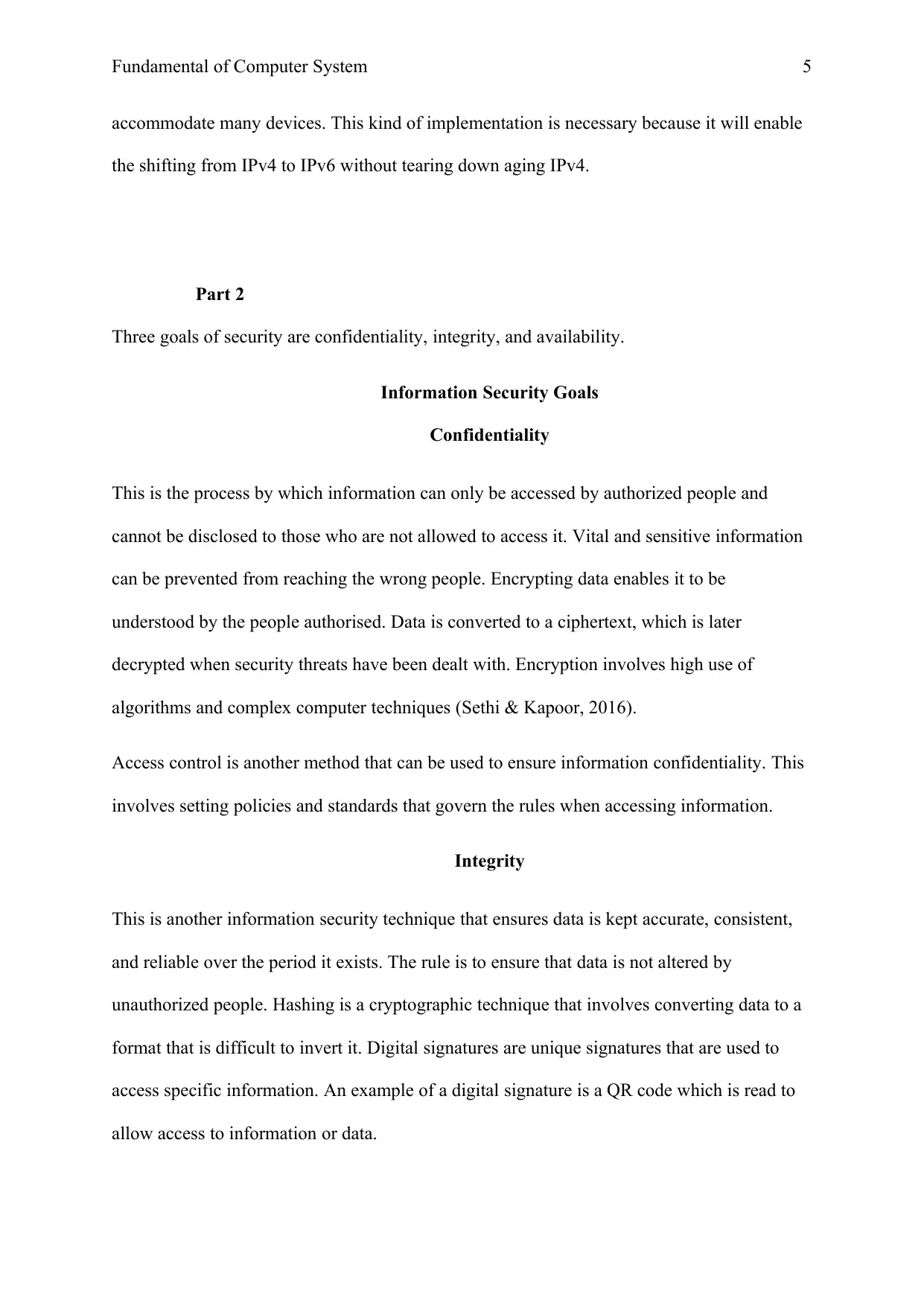
Fundamental of Computer System 5
accommodate many devices. This kind of implementation is necessary because it will enable
the shifting from IPv4 to IPv6 without tearing down aging IPv4.
Part 2
Three goals of security are confidentiality, integrity, and availability.
Information Security Goals
Confidentiality
This is the process by which information can only be accessed by authorized people and
cannot be disclosed to those who are not allowed to access it. Vital and sensitive information
can be prevented from reaching the wrong people. Encrypting data enables it to be
understood by the people authorised. Data is converted to a ciphertext, which is later
decrypted when security threats have been dealt with. Encryption involves high use of
algorithms and complex computer techniques (Sethi & Kapoor, 2016).
Access control is another method that can be used to ensure information confidentiality. This
involves setting policies and standards that govern the rules when accessing information.
Integrity
This is another information security technique that ensures data is kept accurate, consistent,
and reliable over the period it exists. The rule is to ensure that data is not altered by
unauthorized people. Hashing is a cryptographic technique that involves converting data to a
format that is difficult to invert it. Digital signatures are unique signatures that are used to
access specific information. An example of a digital signature is a QR code which is read to
allow access to information or data.
accommodate many devices. This kind of implementation is necessary because it will enable
the shifting from IPv4 to IPv6 without tearing down aging IPv4.
Part 2
Three goals of security are confidentiality, integrity, and availability.
Information Security Goals
Confidentiality
This is the process by which information can only be accessed by authorized people and
cannot be disclosed to those who are not allowed to access it. Vital and sensitive information
can be prevented from reaching the wrong people. Encrypting data enables it to be
understood by the people authorised. Data is converted to a ciphertext, which is later
decrypted when security threats have been dealt with. Encryption involves high use of
algorithms and complex computer techniques (Sethi & Kapoor, 2016).
Access control is another method that can be used to ensure information confidentiality. This
involves setting policies and standards that govern the rules when accessing information.
Integrity
This is another information security technique that ensures data is kept accurate, consistent,
and reliable over the period it exists. The rule is to ensure that data is not altered by
unauthorized people. Hashing is a cryptographic technique that involves converting data to a
format that is difficult to invert it. Digital signatures are unique signatures that are used to
access specific information. An example of a digital signature is a QR code which is read to
allow access to information or data.
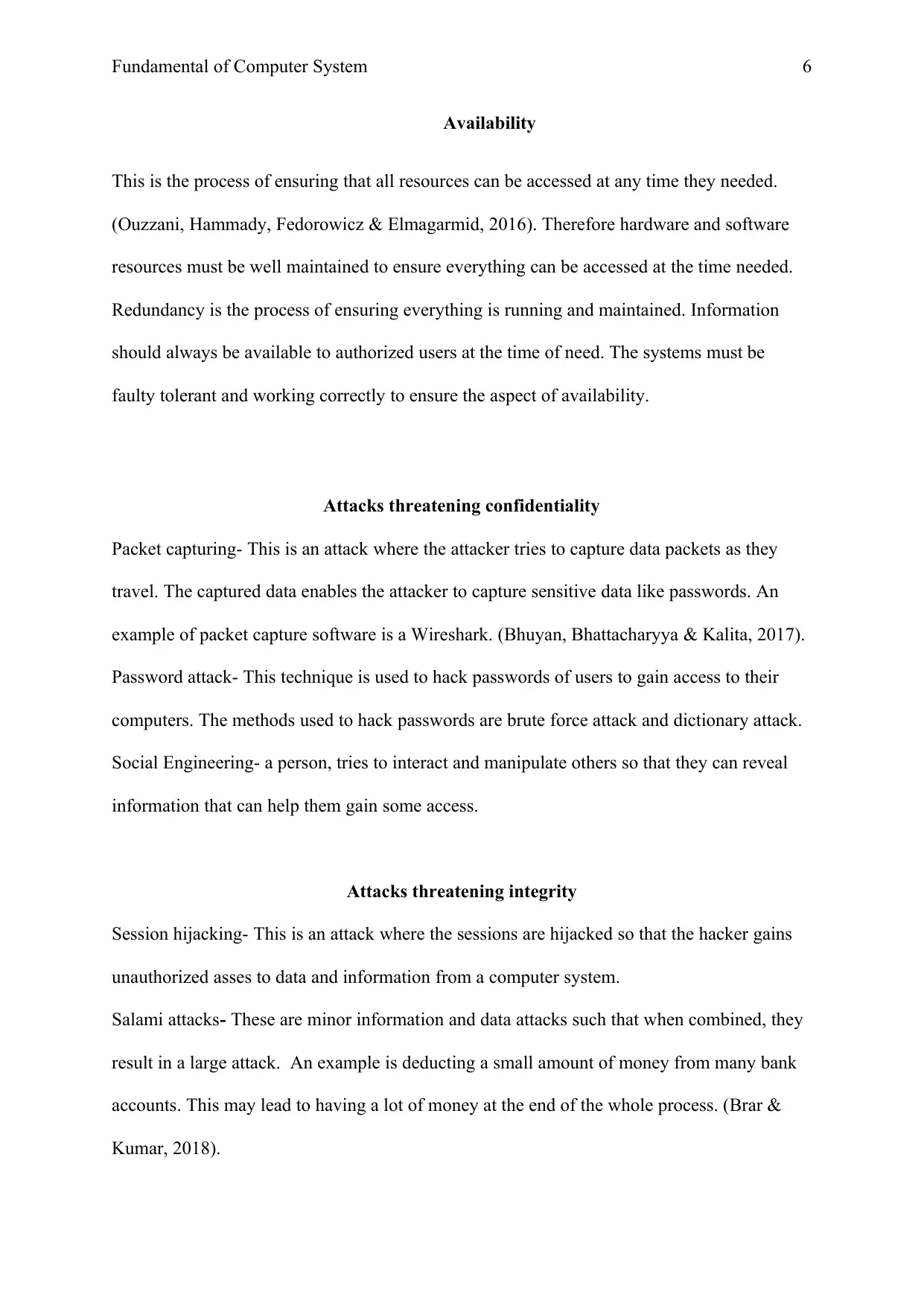
Fundamental of Computer System 6
Availability
This is the process of ensuring that all resources can be accessed at any time they needed.
(Ouzzani, Hammady, Fedorowicz & Elmagarmid, 2016). Therefore hardware and software
resources must be well maintained to ensure everything can be accessed at the time needed.
Redundancy is the process of ensuring everything is running and maintained. Information
should always be available to authorized users at the time of need. The systems must be
faulty tolerant and working correctly to ensure the aspect of availability.
Attacks threatening confidentiality
Packet capturing- This is an attack where the attacker tries to capture data packets as they
travel. The captured data enables the attacker to capture sensitive data like passwords. An
example of packet capture software is a Wireshark. (Bhuyan, Bhattacharyya & Kalita, 2017).
Password attack- This technique is used to hack passwords of users to gain access to their
computers. The methods used to hack passwords are brute force attack and dictionary attack.
Social Engineering- a person, tries to interact and manipulate others so that they can reveal
information that can help them gain some access.
Attacks threatening integrity
Session hijacking- This is an attack where the sessions are hijacked so that the hacker gains
unauthorized asses to data and information from a computer system.
Salami attacks- These are minor information and data attacks such that when combined, they
result in a large attack. An example is deducting a small amount of money from many bank
accounts. This may lead to having a lot of money at the end of the whole process. (Brar &
Kumar, 2018).
Availability
This is the process of ensuring that all resources can be accessed at any time they needed.
(Ouzzani, Hammady, Fedorowicz & Elmagarmid, 2016). Therefore hardware and software
resources must be well maintained to ensure everything can be accessed at the time needed.
Redundancy is the process of ensuring everything is running and maintained. Information
should always be available to authorized users at the time of need. The systems must be
faulty tolerant and working correctly to ensure the aspect of availability.
Attacks threatening confidentiality
Packet capturing- This is an attack where the attacker tries to capture data packets as they
travel. The captured data enables the attacker to capture sensitive data like passwords. An
example of packet capture software is a Wireshark. (Bhuyan, Bhattacharyya & Kalita, 2017).
Password attack- This technique is used to hack passwords of users to gain access to their
computers. The methods used to hack passwords are brute force attack and dictionary attack.
Social Engineering- a person, tries to interact and manipulate others so that they can reveal
information that can help them gain some access.
Attacks threatening integrity
Session hijacking- This is an attack where the sessions are hijacked so that the hacker gains
unauthorized asses to data and information from a computer system.
Salami attacks- These are minor information and data attacks such that when combined, they
result in a large attack. An example is deducting a small amount of money from many bank
accounts. This may lead to having a lot of money at the end of the whole process. (Brar &
Kumar, 2018).
⊘ This is a preview!⊘
Do you want full access?
Subscribe today to unlock all pages.

Trusted by 1+ million students worldwide
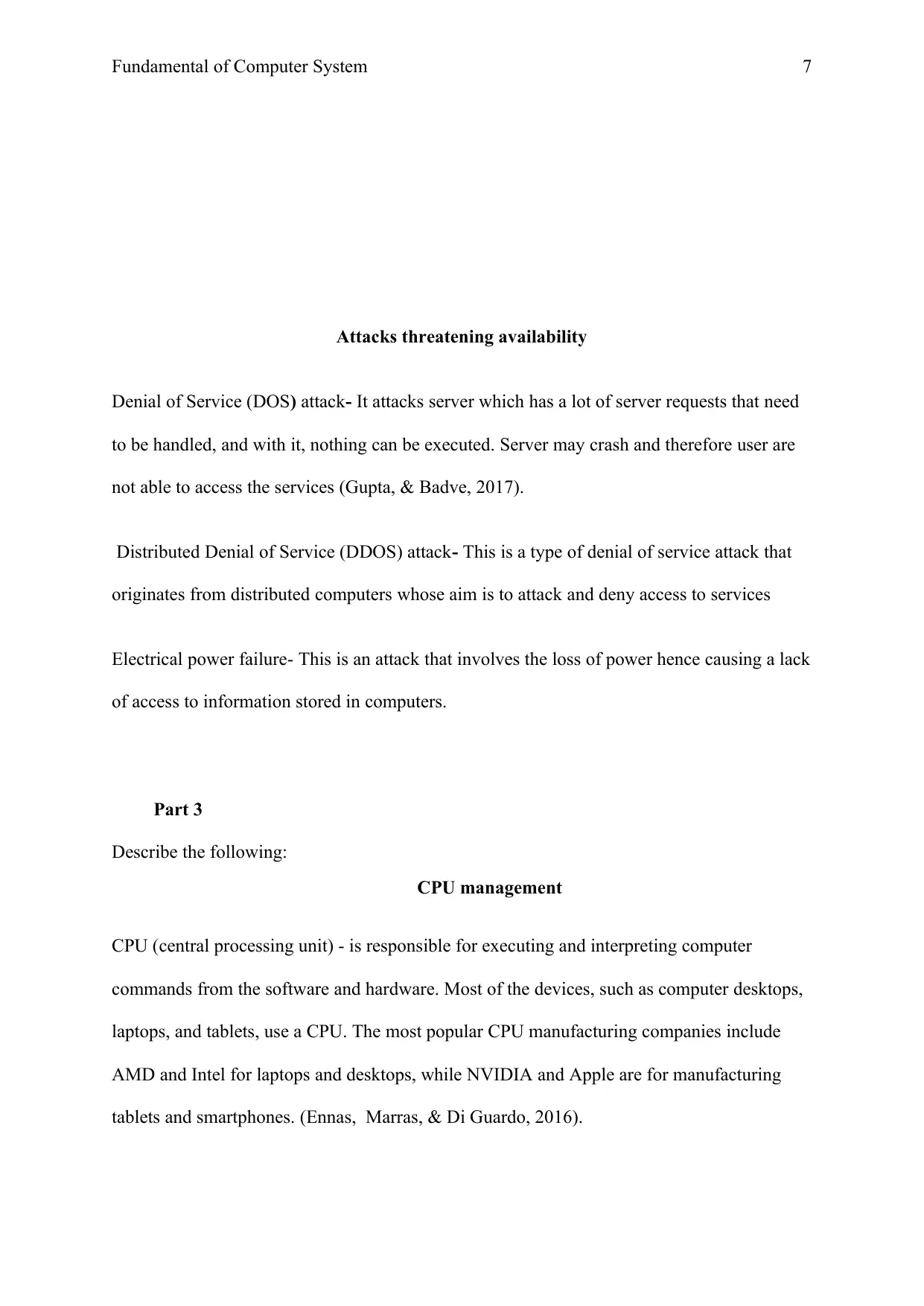
Fundamental of Computer System 7
Attacks threatening availability
Denial of Service (DOS) attack- It attacks server which has a lot of server requests that need
to be handled, and with it, nothing can be executed. Server may crash and therefore user are
not able to access the services (Gupta, & Badve, 2017).
Distributed Denial of Service (DDOS) attack- This is a type of denial of service attack that
originates from distributed computers whose aim is to attack and deny access to services
Electrical power failure- This is an attack that involves the loss of power hence causing a lack
of access to information stored in computers.
Part 3
Describe the following:
CPU management
CPU (central processing unit) - is responsible for executing and interpreting computer
commands from the software and hardware. Most of the devices, such as computer desktops,
laptops, and tablets, use a CPU. The most popular CPU manufacturing companies include
AMD and Intel for laptops and desktops, while NVIDIA and Apple are for manufacturing
tablets and smartphones. (Ennas, Marras, & Di Guardo, 2016).
Attacks threatening availability
Denial of Service (DOS) attack- It attacks server which has a lot of server requests that need
to be handled, and with it, nothing can be executed. Server may crash and therefore user are
not able to access the services (Gupta, & Badve, 2017).
Distributed Denial of Service (DDOS) attack- This is a type of denial of service attack that
originates from distributed computers whose aim is to attack and deny access to services
Electrical power failure- This is an attack that involves the loss of power hence causing a lack
of access to information stored in computers.
Part 3
Describe the following:
CPU management
CPU (central processing unit) - is responsible for executing and interpreting computer
commands from the software and hardware. Most of the devices, such as computer desktops,
laptops, and tablets, use a CPU. The most popular CPU manufacturing companies include
AMD and Intel for laptops and desktops, while NVIDIA and Apple are for manufacturing
tablets and smartphones. (Ennas, Marras, & Di Guardo, 2016).
Paraphrase This Document
Need a fresh take? Get an instant paraphrase of this document with our AI Paraphraser
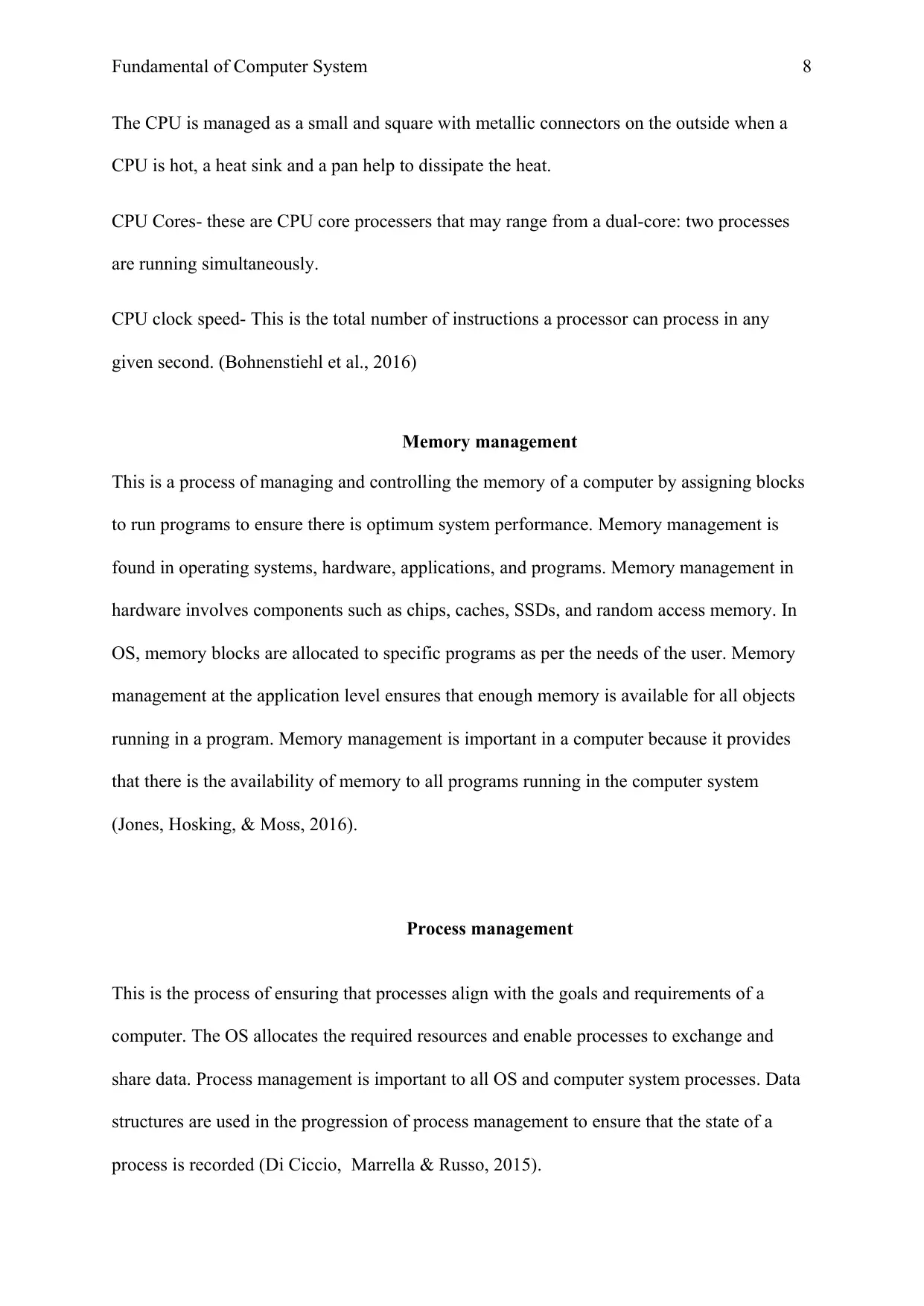
Fundamental of Computer System 8
The CPU is managed as a small and square with metallic connectors on the outside when a
CPU is hot, a heat sink and a pan help to dissipate the heat.
CPU Cores- these are CPU core processers that may range from a dual-core: two processes
are running simultaneously.
CPU clock speed- This is the total number of instructions a processor can process in any
given second. (Bohnenstiehl et al., 2016)
Memory management
This is a process of managing and controlling the memory of a computer by assigning blocks
to run programs to ensure there is optimum system performance. Memory management is
found in operating systems, hardware, applications, and programs. Memory management in
hardware involves components such as chips, caches, SSDs, and random access memory. In
OS, memory blocks are allocated to specific programs as per the needs of the user. Memory
management at the application level ensures that enough memory is available for all objects
running in a program. Memory management is important in a computer because it provides
that there is the availability of memory to all programs running in the computer system
(Jones, Hosking, & Moss, 2016).
Process management
This is the process of ensuring that processes align with the goals and requirements of a
computer. The OS allocates the required resources and enable processes to exchange and
share data. Process management is important to all OS and computer system processes. Data
structures are used in the progression of process management to ensure that the state of a
process is recorded (Di Ciccio, Marrella & Russo, 2015).
The CPU is managed as a small and square with metallic connectors on the outside when a
CPU is hot, a heat sink and a pan help to dissipate the heat.
CPU Cores- these are CPU core processers that may range from a dual-core: two processes
are running simultaneously.
CPU clock speed- This is the total number of instructions a processor can process in any
given second. (Bohnenstiehl et al., 2016)
Memory management
This is a process of managing and controlling the memory of a computer by assigning blocks
to run programs to ensure there is optimum system performance. Memory management is
found in operating systems, hardware, applications, and programs. Memory management in
hardware involves components such as chips, caches, SSDs, and random access memory. In
OS, memory blocks are allocated to specific programs as per the needs of the user. Memory
management at the application level ensures that enough memory is available for all objects
running in a program. Memory management is important in a computer because it provides
that there is the availability of memory to all programs running in the computer system
(Jones, Hosking, & Moss, 2016).
Process management
This is the process of ensuring that processes align with the goals and requirements of a
computer. The OS allocates the required resources and enable processes to exchange and
share data. Process management is important to all OS and computer system processes. Data
structures are used in the progression of process management to ensure that the state of a
process is recorded (Di Ciccio, Marrella & Russo, 2015).
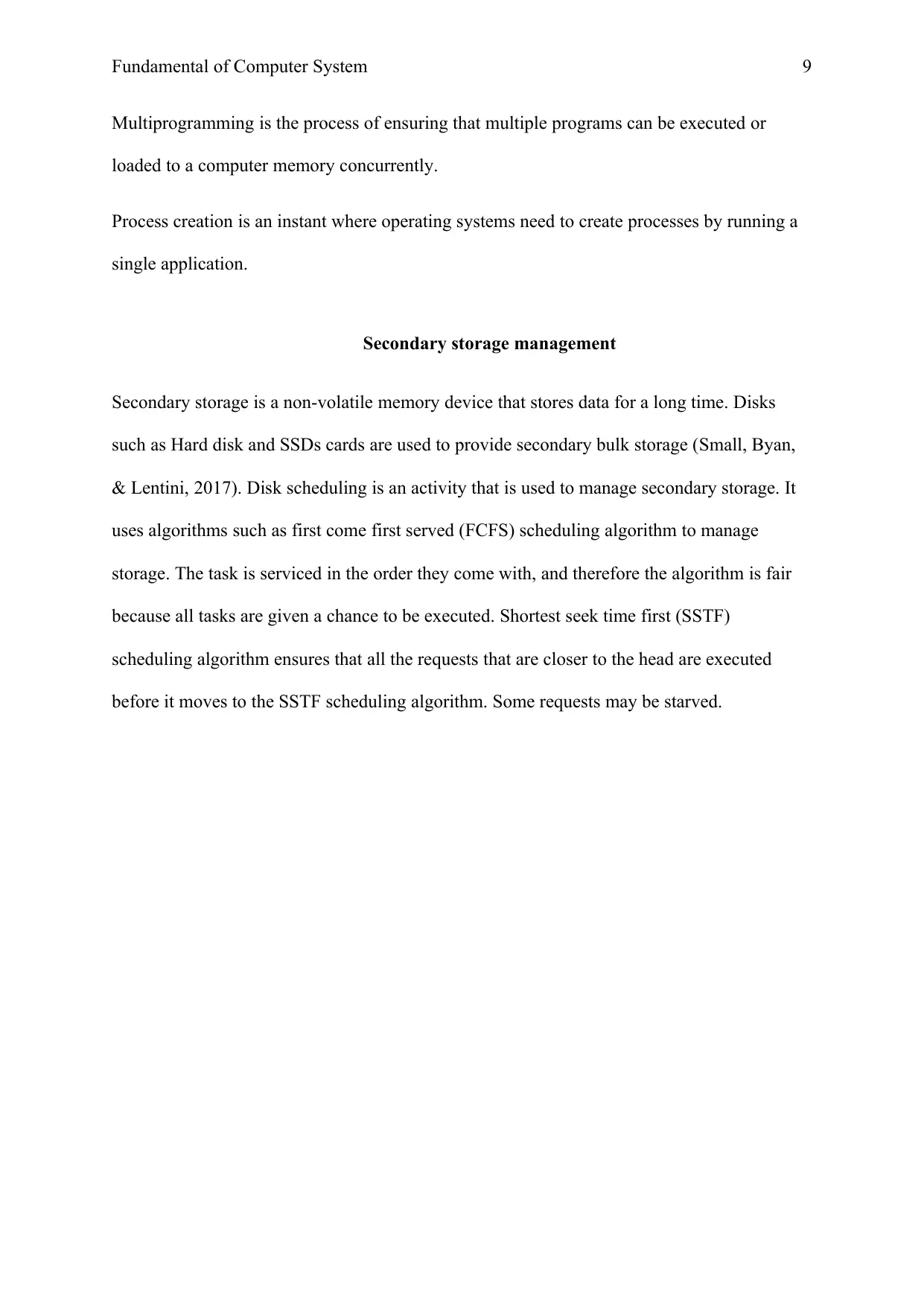
Fundamental of Computer System 9
Multiprogramming is the process of ensuring that multiple programs can be executed or
loaded to a computer memory concurrently.
Process creation is an instant where operating systems need to create processes by running a
single application.
Secondary storage management
Secondary storage is a non-volatile memory device that stores data for a long time. Disks
such as Hard disk and SSDs cards are used to provide secondary bulk storage (Small, Byan,
& Lentini, 2017). Disk scheduling is an activity that is used to manage secondary storage. It
uses algorithms such as first come first served (FCFS) scheduling algorithm to manage
storage. The task is serviced in the order they come with, and therefore the algorithm is fair
because all tasks are given a chance to be executed. Shortest seek time first (SSTF)
scheduling algorithm ensures that all the requests that are closer to the head are executed
before it moves to the SSTF scheduling algorithm. Some requests may be starved.
Multiprogramming is the process of ensuring that multiple programs can be executed or
loaded to a computer memory concurrently.
Process creation is an instant where operating systems need to create processes by running a
single application.
Secondary storage management
Secondary storage is a non-volatile memory device that stores data for a long time. Disks
such as Hard disk and SSDs cards are used to provide secondary bulk storage (Small, Byan,
& Lentini, 2017). Disk scheduling is an activity that is used to manage secondary storage. It
uses algorithms such as first come first served (FCFS) scheduling algorithm to manage
storage. The task is serviced in the order they come with, and therefore the algorithm is fair
because all tasks are given a chance to be executed. Shortest seek time first (SSTF)
scheduling algorithm ensures that all the requests that are closer to the head are executed
before it moves to the SSTF scheduling algorithm. Some requests may be starved.
⊘ This is a preview!⊘
Do you want full access?
Subscribe today to unlock all pages.

Trusted by 1+ million students worldwide
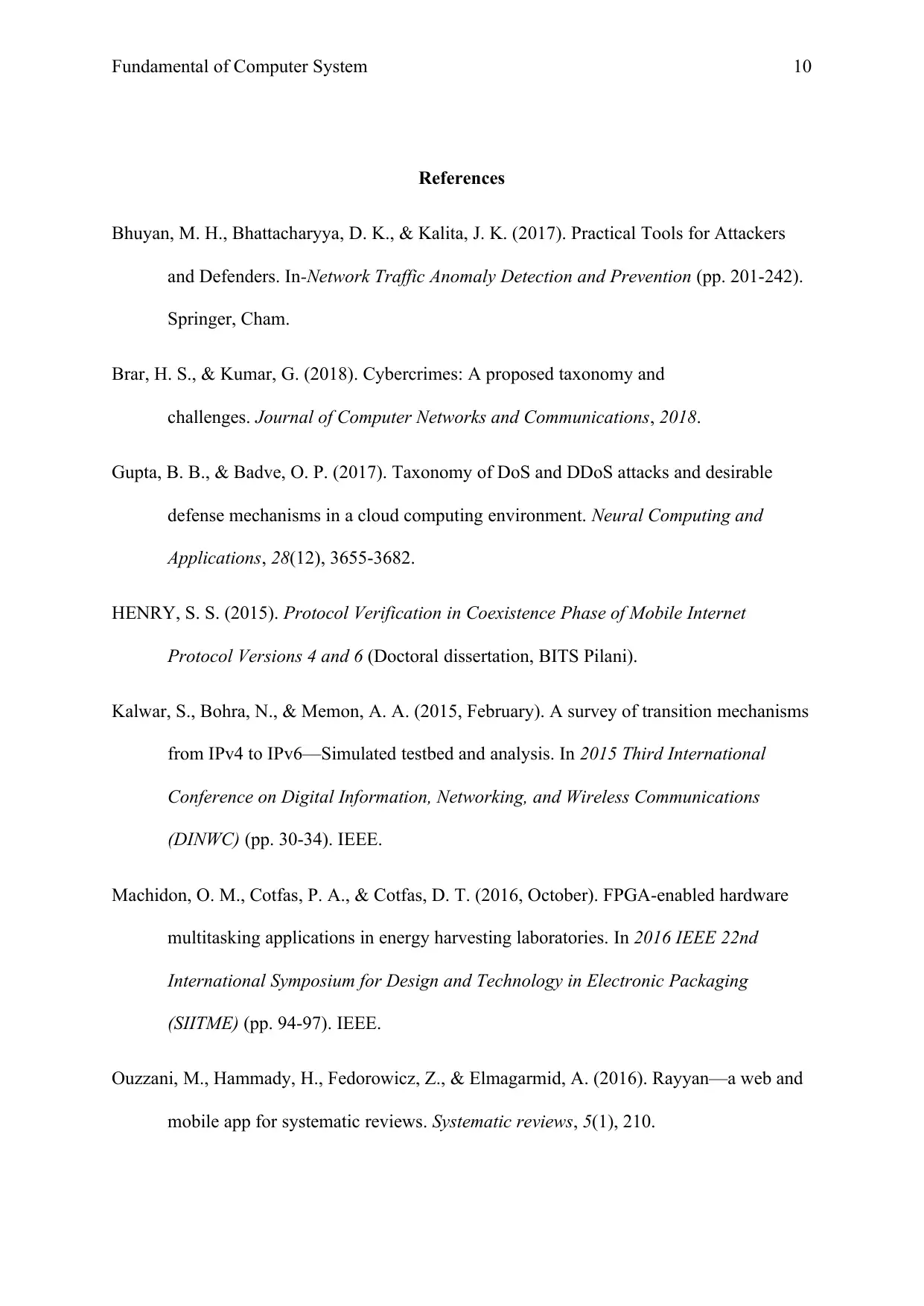
Fundamental of Computer System 10
References
Bhuyan, M. H., Bhattacharyya, D. K., & Kalita, J. K. (2017). Practical Tools for Attackers
and Defenders. In-Network Traffic Anomaly Detection and Prevention (pp. 201-242).
Springer, Cham.
Brar, H. S., & Kumar, G. (2018). Cybercrimes: A proposed taxonomy and
challenges. Journal of Computer Networks and Communications, 2018.
Gupta, B. B., & Badve, O. P. (2017). Taxonomy of DoS and DDoS attacks and desirable
defense mechanisms in a cloud computing environment. Neural Computing and
Applications, 28(12), 3655-3682.
HENRY, S. S. (2015). Protocol Verification in Coexistence Phase of Mobile Internet
Protocol Versions 4 and 6 (Doctoral dissertation, BITS Pilani).
Kalwar, S., Bohra, N., & Memon, A. A. (2015, February). A survey of transition mechanisms
from IPv4 to IPv6—Simulated testbed and analysis. In 2015 Third International
Conference on Digital Information, Networking, and Wireless Communications
(DINWC) (pp. 30-34). IEEE.
Machidon, O. M., Cotfas, P. A., & Cotfas, D. T. (2016, October). FPGA-enabled hardware
multitasking applications in energy harvesting laboratories. In 2016 IEEE 22nd
International Symposium for Design and Technology in Electronic Packaging
(SIITME) (pp. 94-97). IEEE.
Ouzzani, M., Hammady, H., Fedorowicz, Z., & Elmagarmid, A. (2016). Rayyan—a web and
mobile app for systematic reviews. Systematic reviews, 5(1), 210.
References
Bhuyan, M. H., Bhattacharyya, D. K., & Kalita, J. K. (2017). Practical Tools for Attackers
and Defenders. In-Network Traffic Anomaly Detection and Prevention (pp. 201-242).
Springer, Cham.
Brar, H. S., & Kumar, G. (2018). Cybercrimes: A proposed taxonomy and
challenges. Journal of Computer Networks and Communications, 2018.
Gupta, B. B., & Badve, O. P. (2017). Taxonomy of DoS and DDoS attacks and desirable
defense mechanisms in a cloud computing environment. Neural Computing and
Applications, 28(12), 3655-3682.
HENRY, S. S. (2015). Protocol Verification in Coexistence Phase of Mobile Internet
Protocol Versions 4 and 6 (Doctoral dissertation, BITS Pilani).
Kalwar, S., Bohra, N., & Memon, A. A. (2015, February). A survey of transition mechanisms
from IPv4 to IPv6—Simulated testbed and analysis. In 2015 Third International
Conference on Digital Information, Networking, and Wireless Communications
(DINWC) (pp. 30-34). IEEE.
Machidon, O. M., Cotfas, P. A., & Cotfas, D. T. (2016, October). FPGA-enabled hardware
multitasking applications in energy harvesting laboratories. In 2016 IEEE 22nd
International Symposium for Design and Technology in Electronic Packaging
(SIITME) (pp. 94-97). IEEE.
Ouzzani, M., Hammady, H., Fedorowicz, Z., & Elmagarmid, A. (2016). Rayyan—a web and
mobile app for systematic reviews. Systematic reviews, 5(1), 210.
Paraphrase This Document
Need a fresh take? Get an instant paraphrase of this document with our AI Paraphraser
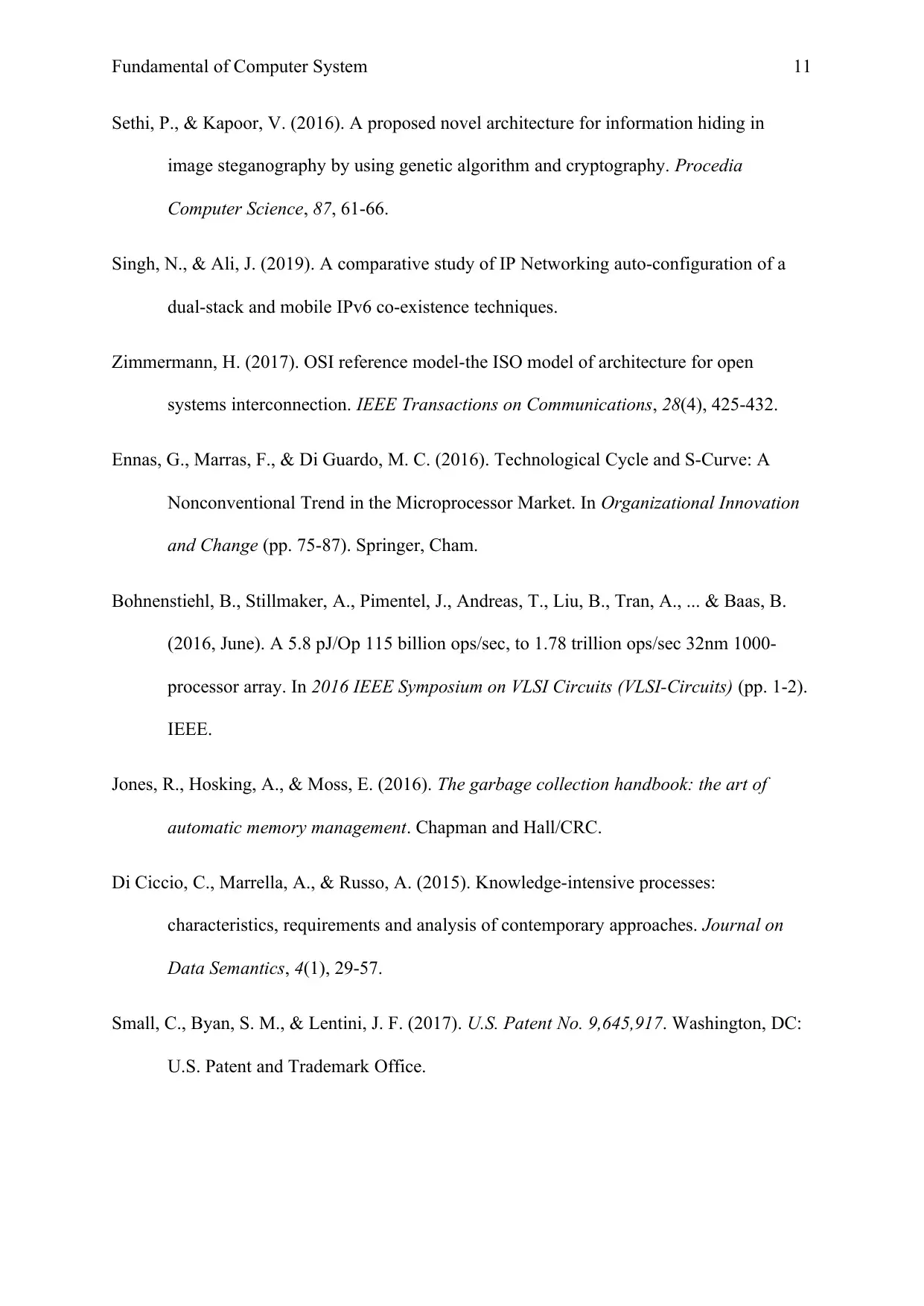
Fundamental of Computer System 11
Sethi, P., & Kapoor, V. (2016). A proposed novel architecture for information hiding in
image steganography by using genetic algorithm and cryptography. Procedia
Computer Science, 87, 61-66.
Singh, N., & Ali, J. (2019). A comparative study of IP Networking auto-configuration of a
dual-stack and mobile IPv6 co-existence techniques.
Zimmermann, H. (2017). OSI reference model-the ISO model of architecture for open
systems interconnection. IEEE Transactions on Communications, 28(4), 425-432.
Ennas, G., Marras, F., & Di Guardo, M. C. (2016). Technological Cycle and S-Curve: A
Nonconventional Trend in the Microprocessor Market. In Organizational Innovation
and Change (pp. 75-87). Springer, Cham.
Bohnenstiehl, B., Stillmaker, A., Pimentel, J., Andreas, T., Liu, B., Tran, A., ... & Baas, B.
(2016, June). A 5.8 pJ/Op 115 billion ops/sec, to 1.78 trillion ops/sec 32nm 1000-
processor array. In 2016 IEEE Symposium on VLSI Circuits (VLSI-Circuits) (pp. 1-2).
IEEE.
Jones, R., Hosking, A., & Moss, E. (2016). The garbage collection handbook: the art of
automatic memory management. Chapman and Hall/CRC.
Di Ciccio, C., Marrella, A., & Russo, A. (2015). Knowledge-intensive processes:
characteristics, requirements and analysis of contemporary approaches. Journal on
Data Semantics, 4(1), 29-57.
Small, C., Byan, S. M., & Lentini, J. F. (2017). U.S. Patent No. 9,645,917. Washington, DC:
U.S. Patent and Trademark Office.
Sethi, P., & Kapoor, V. (2016). A proposed novel architecture for information hiding in
image steganography by using genetic algorithm and cryptography. Procedia
Computer Science, 87, 61-66.
Singh, N., & Ali, J. (2019). A comparative study of IP Networking auto-configuration of a
dual-stack and mobile IPv6 co-existence techniques.
Zimmermann, H. (2017). OSI reference model-the ISO model of architecture for open
systems interconnection. IEEE Transactions on Communications, 28(4), 425-432.
Ennas, G., Marras, F., & Di Guardo, M. C. (2016). Technological Cycle and S-Curve: A
Nonconventional Trend in the Microprocessor Market. In Organizational Innovation
and Change (pp. 75-87). Springer, Cham.
Bohnenstiehl, B., Stillmaker, A., Pimentel, J., Andreas, T., Liu, B., Tran, A., ... & Baas, B.
(2016, June). A 5.8 pJ/Op 115 billion ops/sec, to 1.78 trillion ops/sec 32nm 1000-
processor array. In 2016 IEEE Symposium on VLSI Circuits (VLSI-Circuits) (pp. 1-2).
IEEE.
Jones, R., Hosking, A., & Moss, E. (2016). The garbage collection handbook: the art of
automatic memory management. Chapman and Hall/CRC.
Di Ciccio, C., Marrella, A., & Russo, A. (2015). Knowledge-intensive processes:
characteristics, requirements and analysis of contemporary approaches. Journal on
Data Semantics, 4(1), 29-57.
Small, C., Byan, S. M., & Lentini, J. F. (2017). U.S. Patent No. 9,645,917. Washington, DC:
U.S. Patent and Trademark Office.
1 out of 11
Related Documents
Your All-in-One AI-Powered Toolkit for Academic Success.
+13062052269
info@desklib.com
Available 24*7 on WhatsApp / Email
![[object Object]](/_next/static/media/star-bottom.7253800d.svg)
Unlock your academic potential
Copyright © 2020–2025 A2Z Services. All Rights Reserved. Developed and managed by ZUCOL.



